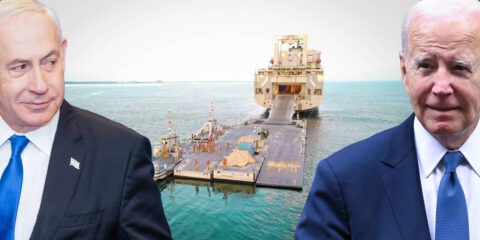At the start of the Gaza War, President Biden warned Iran and its proxies against launching an all-out attack on Israel and sent aircraft carriers to the region to clarify his intentions. The withdrawal of the Gerald R. Ford carrier from the Mediterranean could be interpreted as a sign of American weakness, diminish deterrence of Iran, and undermine US mediation efforts in Lebanon.
The United States is sending contradictory messages to the region. On the one hand, the aircraft carrier Gerald R. Ford is heading back to its home base and Washington has shown restraint in the face of attacks against its bases in Syria and Iraq; on the other, it has finally retaliated against the Yemen Houthis who have captured and attacked merchant ships in the Red Sea. The return of the Ford to its base does not significantly harm the military preparedness of the United States in the region. It may stem from Washington’s assessment that the willingness to act against the Houthis sufficiently establishes American deterrence against Iran, but this is rational Western thought, something that has failed in our region more than once.
Since the beginning of the war against Hamas in Gaza, Hezbollah in southern Lebanon, and pro-Iranian militias in Syria and Iraq, the United States has deployed large and powerful forces in the Middle East to achieve important strategic goals. Washington’s primary goal is to prevent a large-scale regional war; and, in the event that the war broadens, to provide direct military assistance to the IDF, at least by intercepting missiles, and evacuating American civilians from combat zones. Houthi missile and drone attacks on Israel and against merchant ships in the Red Sea necessitated military deployments in the Bab el-Mandeb Strait in addition to its initial Mediterranean deployment.
To deter Iran and its proxies from an all-out attack on Israel, the Biden administration warned them against doing so, and to make clear that his intentions were serious, President Biden sent the USS Gerald R. Ford aircraft carrier to the Eastern Mediterranean and another carrier, the USS Dwight D. Eisenhower to the Gulf of Aden, both accompanied by their strike groups. In early November 2023, a nuclear-powered submarine, the USS Florida, and the USS Bataan, an amphibious assault ship carrying about 2,000 Marines, were also deployed to the Gulf. The United States, Britain, and other NATO countries further sent planes, helicopters and special forces to be on standby in Cyprus.
Aircraft carriers are large air bases. The Ford is the largest and most sophisticated aircraft carrier in the U.S. Navy. It is powered by two nuclear reactors, carries some 80 fighter jets, and electronic warfare and intelligence platforms operated by a crew of around 4,500 people. It is equipped with defense and attack missile systems and escorted by between three to five missile ships. The Eisenhower carries 60 aircraft and 5,000 crew and is accompanied by three missile ships. The submarine Florida is powered by a nuclear reactor and is equipped with some 50 Tomahawk missiles with a range of approximately 2,500 km.
Ford strike group returns to Virginia
In early 2024, the Americans announced that the Gerald R. Ford Carrier Strike Group would return to port in Norfolk, Virginia. A statement said the return was for prescheduled maintenance and that the Ford was supposed to have returned to its home port before the war broke out in Gaza but was diverted to the Mediterranean in the wake of its outbreak. The Americans said they had sufficient military forces in the Mediterranean and Red Sea to meet any challenge, and that the return of the Ford did not signal the abandonment of Israel. It is true that the Americans still have strong forces in the region, but, nevertheless, these explanations raise a few questions.
Hezbollah meanwhile has escalated its attacks on military outposts and civilian communities, and the IDF is responding accordingly. It is clear that Israel is not prepared to return to the situation that prevailed on the northern border before the Gaza war; it is demanding the redeployment of Hezbollah’s Radwan forces behind the Litani River, as stipulated in UN Security Council Resolution 1701 of August 12, 2006. The resolution ended the Second Lebanon War, but Lebanon and Hezbollah violated it.
Israel has told the United States that it can attempt to resolve the Hezbollah threat through diplomacy but has warned that if the US fails it will be left with no alternative other than military force. In the face of increasing attacks on Israeli communities, time to reach an agreement is quickly running out. The Biden administration’s special envoy, Amos Hochstein, who mediated the settlement of the gas agreement between Israel and Lebanon in October 2022, is trying to reach another agreement to prevent the situation from escalating to a full-scale war. At the same time, the IDF is preparing to move to a low-intensity phase of fighting in Gaza and is discharging reserve forces. Until now, Israel argued that it must first focus on Gaza and wage a low-intensity war against Hezbollah – “active defense.” As the war in Gaza moves on to a new phase, this argument is no longer valid.
The deployment of the Ford in the Mediterranean symbolized American determination to act against Hezbollah and Iran. The danger of an all-out war in Lebanon has increased as a result of miscalculation or perhaps even planning by Iran and Hezbollah. The targeted killing of Saleh al-Arouri, one of the most prominent members of Hamas’ leadership abroad, in Beirut’s Dahiya district on January 2, 2024, and subsequently senior Hizballah commanders Wissam Hassan Tawil, the commander of Hezbollah’s Radwan special operation forces, and Ali Hussein Barji, the Commander of the Southern Lebanon Region of Hezbollah’s Aerial Unit, raised the probability of an escalation of the war in Lebanon. The withdrawal of the Ford could be interpreted as a sign of American weakness, diminish deterrence of Iran, and undermine Hochstein’s mediation efforts. On the other hand, the presence of the Ford prevented a significant Israeli counterattack against Hezbollah, and now that it has left, Israel will be able to attack Lebanon with greater force.
Attacks on Red Sea shipping
Under Iranian guidance or encouragement, Yemen’s Houthi rebels have attacked Israel with missiles and drones, most of which were intercepted by U.S. naval forces. They have also intensified their attacks on merchant shipping under the dubious claim that ships attacked were Israeli-owned or transporting goods to the port of Eilat; the result has been paralysis of the Bab el-Mandeb Strait and has led the world’s largest shipping companies to change shipping routes and sail around Africa instead of crossing the Suez Canal to the Mediterranean. This has caused a significant increase in sea freight prices.
The United States has responded by forming a coalition of maritime nations to ensure freedom of navigation in the Red Sea. This coalition includes Britain, Bahrain, Canada, France, Italy, the Netherlands, Norway, Seychelles, and Spain. But here deterrence has so far failed. Iran condemned the establishment of the coalition, issued a warning to the force, and said there would be “problems” without specifying what those would be. The Houthis responded that they were not afraid of a confrontation with the United States and the coalition and intensified their attacks. On December 23, 2023, the Pentagon for the first time accused Iran of directing attacks on Red Sea shipping lanes. A day later, the U.S. Navy intercepted missiles targeting merchant ships, and combat helicopters from the aircraft carrier Eisenhower attacked high-speed Houthi boats attempting to seize a Maersk ship, sinking three of them with their crews. The Houthis admitted to losing 10 fighters.
This was the first time that the United States had acted directly against an Iranian proxy in the Gulf of Aden. Yet, the Houthis were continuing their attacks. On January 9, 2024, American and British naval forces shot down 21 drones and missiles fired by the Houthis at a US ship. The United States and Britain have said they are considering a shift from protecting ships to attacking Houthi bases. The Pentagon has recommended strikes, but at this point, Biden has decided not to escalate because he fears this could change the equation and lead to stronger Iranian attacks on US forces in the region. This timid policy has to change.
Syria and Iraq
The United States has many forces and bases throughout the Middle East. Its two largest bases in the region are in Qatar and Bahrain. The U.S. Central Command forward post is located in Qatar, and the Fifth Fleet’s Naval Forces headquarters are in Bahrain. The largest U.S. Navy port outside the United States is in Dubai, United Arab Emirates, and Al Dhafra Air Base in Abu Dhabi, also in the UAE, is home to F-35 stealth fighter jets and drones. American air power stationed at the Al Udeid Air Base in Qatar consists of about 100 aircraft of various types. In total, more than 40,000 U.S. military personnel serve in the region; 13,000 in Kuwait, 11,000 in Qatar, 9,000 in Bahrain, and 5,000 in the UAE. There are a further 2,500 American troops stationed in Iraq and some 900 in Syria, with the deployment in both these countries a remnant of the war against ISIS.
Since the outbreak of the war in Gaza, pro-Iranian militias have attacked American bases in Iraq and Syria 115 times, causing dozens of casualties. So far, the U.S. military has avoided a significant response against the militias for fear of igniting a regional war. These bases are a weak point in the American military deployment in the region, and Iran exploits this to harm American forces through its proxies, as it does throughout the Middle East.
Summary
The United States is sending contradictory messages to the region. On the one hand, the Ford is heading back to its home base and Washington has shown restraint in the face of attacks against its bases in Syria and Iraq; on the other hand, it has attacked Houthi ships. The return of the Ford to its base does not significantly harm the military preparedness of the United States in the region. It may stem from Washington’s assessment that the willingness to act against the Houthis sufficiently establishes American deterrence against Iran, but this is rational Western thought, something that has failed in our region more than once. Moreover, the strike on Houthi ships came only after economic damage to many countries as a result of the Houthi’s actions grew stronger.
There are gaps between actions and perceptions. Israel’s enemies may think that the United States is getting tired and beginning to abandon Israel and the region, and, as a result, will feel more confident to intensify their attacks. On the other hand, the time has come to hit the head of the snake, to challenge and punish Iran, which is the instigator of violence, terrorism, and instability in the entire region – not only its proxies, and not only with economic sanctions.
JISS Policy Papers are published through the generosity of the Greg Rosshandler Family.
Photo: IMAGO / ZUMA Wire / Mc3 Maxwell Orlosky /U.S. Navy








 - בניית אתרים
- בניית אתרים